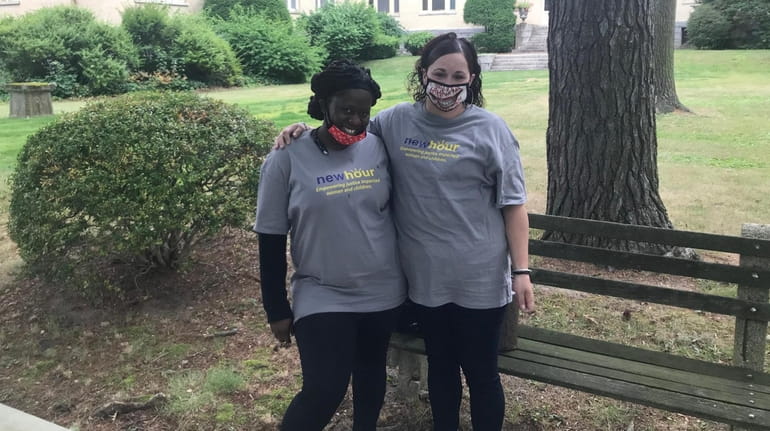Listen: Happy to be back home from jail, but ...

Latoya Rolle, 34, left, and Janean Villanueva, 30, are pictured in Brentwood on July 17, 2020. Credit: Newsday/Mark Chiusano
At first, Latoya Rolle and Janean Villanueva didn’t hear much about the coronavirus in the Yaphank Correctional Facility. It was on the news and far away in China. They were in single cells.
Then, it hit home: their part of the facility was turned into a quarantine location for newly arriving women. And so Rolle and Villanueva were moved to a shared dorm.
You could almost reach over and touch someone, or feel their sneeze, they said.
“Close together, not even six feet apart,” Rolle, 34, said. “I was miserable.”
Rolle and Villanueva, 30, spoke with Newsday for our “Life Under Coronavirus” podcast, an oral history of the pandemic. It was a difficult situation during their time in Yaphank this spring.
Kristin MacKay, director of public relations for the Suffolk County sheriff’s office which oversees the Yaphank and Riverhead jails, said that the bunks may have been closer together early on but “within the first 24 to 48 hours” they were placed 6 feet apart, and staggered so that one woman would be on a top bunk, one on the lower. The housing areas were kept at 50% capacity. That was among the escalating steps MacKay said the jails took, including masks and gloves for correction officers, inmates being spread out, limitations on movement, and, eventually, masks for the inmates.
There have been concerns about jails and prisons in coronavirus hotspots around the country. In the Suffolk facilities over the course of the pandemic, 22 correction officers contracted COVID-19, plus four deputies, said MacKay. One inmate tested positive for COVID-19 while incarcerated, and one came into the jail already positive.
The coronavirus presented other hardships unrelated to health, however. Educational programming as usual was disrupted. Visits stopped, too. The women read and drew, wrote letters and watched TV — for Rolle, “Ellen” every afternoon.
MacKay said that the jails added movie nights and a way for people outside to send photos digitally at reduced cost. And for a brief time, two 15-minute phone calls were allowed per week without charge. Typically, beyond a free five-minute call, calls cost 50 cents a minute.
Rolle and Villanueva both talked about addiction issues and have had their share of charges on that front. They got out of Yaphank in the spring, and they said it was a strange experience to be released into a world on lockdown.
“When I came home, I expected to do everything that I craved to do,” said Villanueva. “And due to COVID I can’t.”
She briefly got a job at Stop & Shop, though that felt dangerous given how close she had to be to customers. She was deeply worried about her mom getting sick, given that her mom is older and has underlying health issues. Rolle’s mother, for her part, was concerned Rolle would bring the virus home.
Villanueva said she had a hard time adjusting to life at home. She would nap at particular times, go to bed at the time she went to bed in jail.
In a way, she actually felt safe in jail, given the restrictions: it felt like more of a “secure” place.
“I’m actually happy to be home but I’m not happy that like there’s restrictions to everything,” she says. “I’m not happy you have to walk around in a mask all day. But that’s what we have to do in order to be safe, right?”
Mark Chiusano is a member of Newsday's editorial board.

